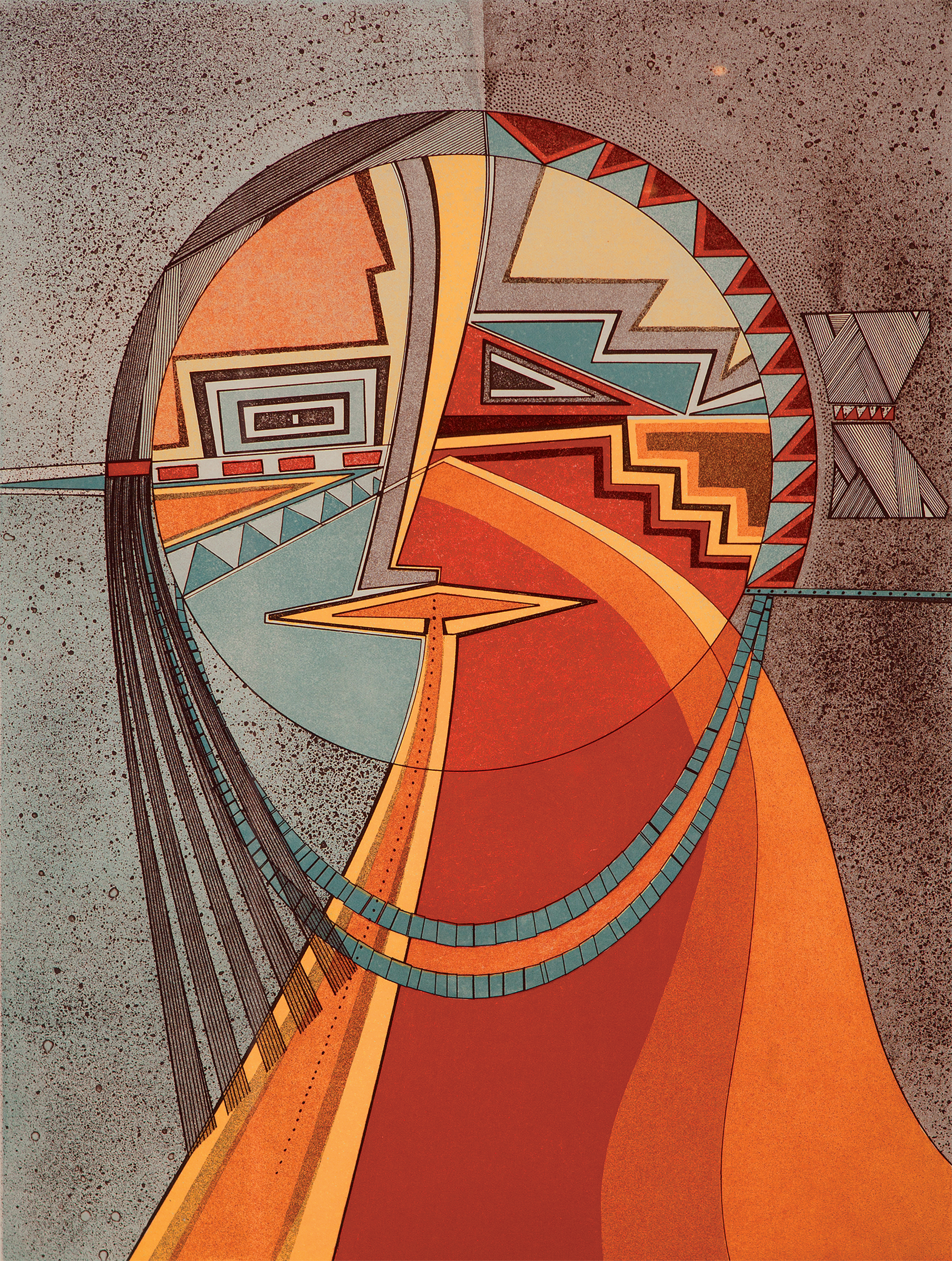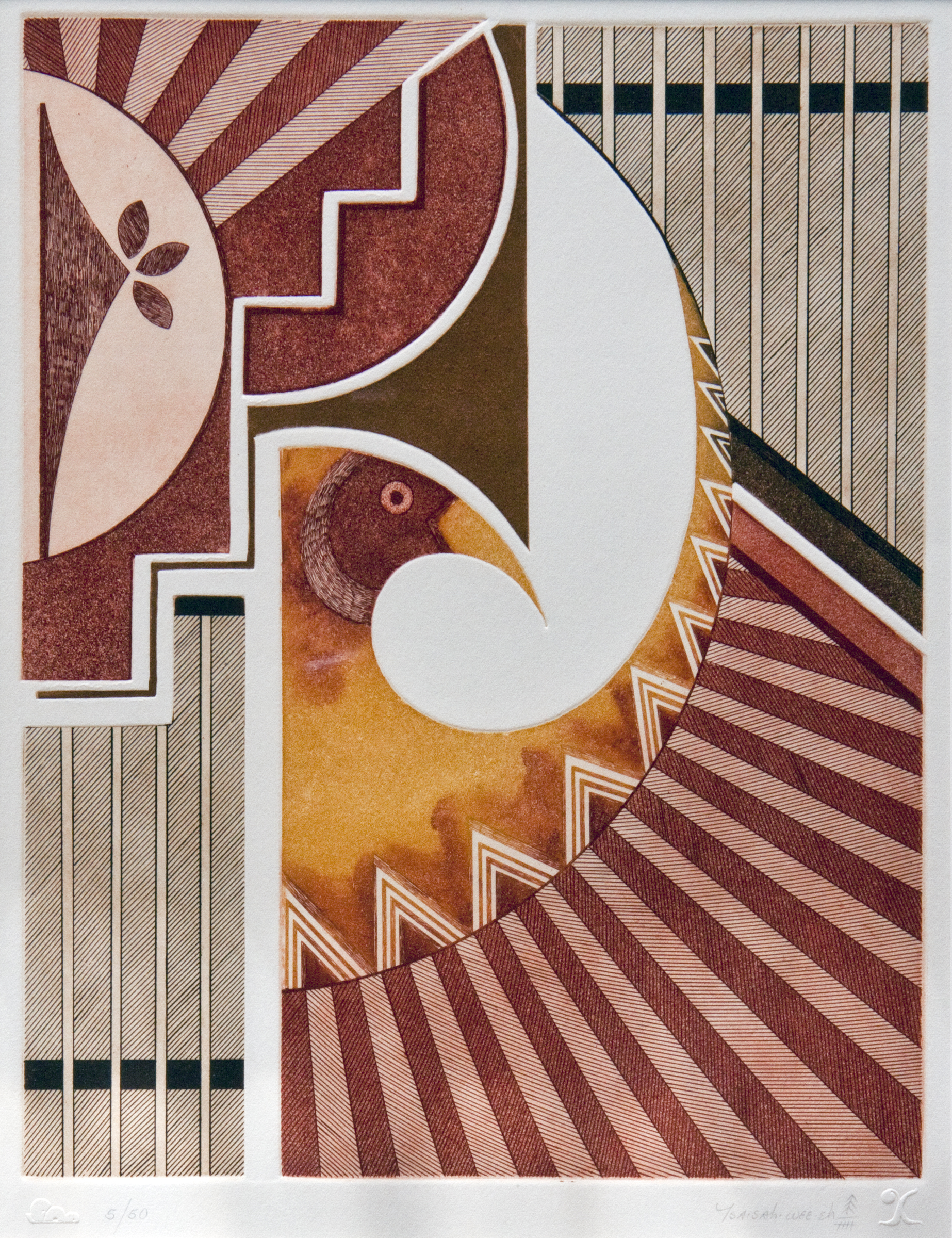Helen Hardin, Deerslayer's Dream, 1981. Etching, ed. 1/65, 18 1/2 x 26 1/8 in. Loan from Helen Hardin #1's LLC.
EXHIBITION TITLE (full): “Spirit Lines: Helen Hardin Etchings, with works by her mother, Pablita Velarde; and daughter, Margarete Bagshaw”
VENUE: Crocker Art Museum (Sacramento, CA)
DATES: February 21 — May 16, 2021
- The 57 objects in this exhibition include paintings and prints by Hardin along with paintings and works on paper by Velarde and Bagshaw.
- Two recently acquired works by Velarde from the Crocker’s permanent collection add context to the life and work of the exhibition’s namesake.
- This exhibition and those of the past, along with the Crocker’s robust and growing holdings of Native American art, including pottery, baskets, paintings, photographs, and prints, make the Crocker Art Museum one California’s premier centers for the study and collecting of 20th- and 21st-century art by First Americans.
(SACRAMENTO, CA — DECEMBER 3, 2021) — “Spirit Lines: Helen Hardin Etchings, with works by her mother, Pablita Velarde; and daughter, Margarete Bagshaw,” an exhibition of 57 works that highlight a contemporary, Native, female artist who, like her mother and daughter, broke from pueblo traditions in media and imagery to forge her own means of expression.
Helen Hardin of Santa Clara Pueblo in New Mexico (Tewa name: Tsa-sah-wee-eh, or “Little Standing Spruce,” 1943–1984) emerged in the 1970s and 1980s as a trailblazing example for Native American artists wishing to break from tradition. Born and having lived her early childhood at Santa Clara with her mother’s family, Hardin spent much of the rest of her life in and around Albuquerque. Her work is informed by time-honored pueblo imagery and the art of her mother, the renowned Pablita Velarde (1918–2006). And yet, Hardin’s art departed radically from both influences. Whereas Velarde rendered more traditional Native American scenes, Hardin created abstractions of her heritage. As Hardin told an interviewer in 1984: “I don’t want to be doing anything that is not completely mine.”
Hardin’s father, Herbert Hardin, was an Anglo-American government employee. Hardin and Velarde divorced when Helen was 13, and Helen was subsequently raised by her mother. Throughout her life, Hardin was faced with cultural challenges created by having a mixed-race background, and she often felt the dualism of living in both worlds. According to the laws and traditions of the time, Hardin was rejected by the Santa Clara Pueblo elders and forbidden to partake in the traditions of her mother’s culture. She also experienced art-world opposition to the fact that she was both Native and female.
Hardin was ever conscious of living in the shadow of her successful mother and sought to distinguish herself creatively. She attended a Catholic high school and took a course in drafting — at the time offered just to boys — and from then on used drafting tools in her art. She next attended the University of New Mexico in Albuquerque, spending a year taking art history and anthropology classes before dropping out. She also took weaving and textile design at the University of Arizona. In 1962, she held her first one-woman show at Coronado Historic Site near Albuquerque.

Helen Hardin, Changing Woman, 1980. Etching, ed. 1/65, 24 3/4 x 18 1/2 in. Loan from Helen Hardin #1's LLC.
In 1964, Hardin gave birth to a daughter, Margarete Bagshaw (1964–2015), who, like her mother and grandmother, would go on to become a respected artist. Four years later, Hardin moved to Bogotá, Colombia, to reconnect with her father who now lived there, distance herself from Santa Clara Pueblo and her mother’s influence, and escape Margarete’s abusive father. Working in relative isolation, her art became more experimental, and when she returned to Albuquerque six months later, she brought with her a new style, one that combined abstractions of imagery from her pueblo heritage with a personal approach to historic motifs that evidenced her knowledge of art history and the relevance of contemporary times. “Changing Woman” from her Women’s Series, for instance, acknowledges Hardin’s own quiet feminism, just as it has been read as an autobiography of the last three years of her life.
Hardin departed from the more traditional “flat style” often used by Native American artists, including her mother, seeking in her own work greater three-dimensionality and, often, translucent effects. She also used vibrant colors, spattering techniques, and metallic paint. At times, her work drew criticism from tribal members, who expressed concern that her mystical figures too closely resembled sacred kachinas, though Hardin was careful to always invent her own. “This is my language,” she explained. “This is how I’m going to talk.”

Helen Hardin, Messenger from the Sun, 1980. Etching, ed. 1/65, 14 x 11 in. Loan from Helen Hardin #1's LLC.
Hardin ultimately became recognized both as a printmaker and a painter. In 1980, she started to make copperplate etchings. This process allowed her to create precise and detailed compositions in multiples that could reach a broad audience. After she was diagnosed with breast cancer in 1981, she continued to produce art, working until her death at age 41.
Spirit Lines consists of Hardin’s copper-plate etchings plus an important group of privately held original paintings. At the Crocker, these works will be accompanied by paintings by Pablita Velarde, who, like her daughter, departed from convention (pottery-making) and broke with precedent to paint narratives of pueblo life. Works by Bagshaw are also included. Bagshaw’s paintings, like her mother’s, are vibrant, abstract, and feature Native American iconography. And yet, like Helen before her, she pushed beyond the limits of the previous generation to create an art recognizably her own.
The Crocker maintains strong holdings of art by Native American women from the late 19th century to the present day. This is especially true in the realm of ceramics, but extends to basketry, painting, photography, printmaking, and other media as well.
“Spirit Lines” extends the impact of two important exhibitions of Native American art held at the Crocker Art Museum in 2019: “When I Remember I See Red: American Indian Art and Activism in California,” and “Pueblo Dynasties: Master Potters from Matriarchs to Contemporaries.” A community exhibition of Native artists from the Sacramento region, “Multiple Horizons: Native Perspectives at the Crossroads,” created in partnership with Arts and Culture El Dorado, features works from California Indian, Native American, and Indigenous artists, community, and youth.
MEDIA CONTACT
Kat Haro
Director of Communications, Crocker Art Museum
(916) 808-1963
communications@crockerart.org

